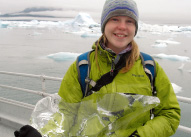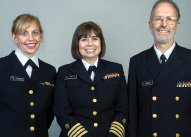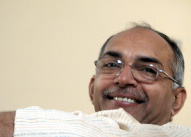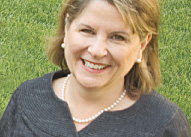

| Spring 2008 | |||||||||
| Current Issue | |||||||||
| A Family Affair A Global Solution for Diabetes Ecology and Public Health Building Public Health Capacity in India 'Big Picture' Thinking A Community of Scholars From the Dean In Brief Alumni News |
|||||||||
| Past Issues Other Publications Contact Us Make a Gift RSPH home |
|||||||||

|
|||||||||
Epidemiologist Laurie Helzer honored for reducing substance abuse
A senior researcher for scf executive and tribal services, Helzer was recognized for leadership in reducing substance abuse in the Anchorage Native Community. She leads an epidemiology work group for the project and is credited with bringing together four partners—SCF, the Cook Inlet Tribal Council, the United Way, and the Municipality of Anchorage—to develop extensive data to document substance abuse in Anchorage. Developing the data in language that each partner could understand was essential to reaching consensus on how to use funds from the Substance Abuse and Mental Health Services Administration.
"Ms. Helzer has helped us find ways to sort through and prioritize information that otherwise would have overwhelmed us," says Cristy Allyn Willer of the Cook Inlet Tribal Council. "When called upon to present these documents and findings to a broader population, she showed great skill in translating numbers and statistics into meaningful information for the general public—absolutely essential for our efforts to acquire informed and enthusiastic input from our advisers."
As head of her work group, Helzer wrote a needs assessment for substance abuse among Alaska Native and American Indian people living in Anchorage and led a team of people to develop a monitoring system for substance abuse indicators.
"One of the hardest things was getting our team to think in terms of a public health model rather than individual behavior change/treatment models since the program required a population-data approach to solving the problems," she says.
Her first journal article appeared in the International Journal of Circumpolar Health 2007. The article analyzed the results of a pilot study to evaluate the use of Nic-Alert immunoassay test strips and liquid chromatography atmospheric-pressure ionization tandem mass spectrometry to measure tobacco use and secondhand smoke exposure among Alaska Native pregnant women.
"The entire supplement of the journal is about the organization I work for, so that made it quite a bit easier," says Helzer of her first foray into publishing. "I learned a lot in the process. All in all, it's been quite a year."
Back to top

| ny | tiny font | ny |
| CDC colleagues Amy Parker, Patricia Riley, and Rob Quick |
RSPH alumna, adjunct faculty earn accolades for safe water intervention in Kenya
More and more health care workers in developing nations are promoting safe water treatment and hand hygiene because of Amy Parker, 05MSN/MPH and two CDC colleagues who serve as RSPH adjunct faculty.
Their success earned them the 2007 GlaxoSmithKline Circle of Excellence award for practices and programs that promote prevention, improve safety, or enhance health care quality.
Parker, Patricia Riley, and Rob Quick received the accolade for their Safe Water Program pilot intervention of safe water and hand hygiene promotion in Homa Bay District Hospital in Kenya. Their research project demonstrated the effectiveness of collaborating with local stakeholders in promoting water treatment and hand washing in a rural, impoverished area of Kenya.
"We were thrilled that 71% of patients were treating their household water during our follow-up study a year after they were initially taught the information at the clinic," says Parker, a CDC epidemiologist in viral diseases. "As a result of the success in our Homa Bay pilot site, the water treatment and hand washing curriculum for health care workers is now being used in many developing countries worldwide."
The team credits their success to the project's stakeholders: CDC's Safe Water Program, the Emory Center for Global Safe Water at the RSPH, the Lillian Carter Center for International Nursing at Emory, care/care Kenya, the Kenya Ministry of Health, and the Nursing Council of Kenya.
"Without this collective input, the project and its subsequent success never would have been realized," says Riley, a nurse midwife with the CDC's Global AIDS Program.
"We did not expect that busy nurses in rural Kenya would be able to find the time to add this one small, but critical piece to their daily practice," adds Quick, a medical epidemiologist in enteric diseases. "They embraced it enthusiastically and made a difference. This is an idea that we are now trying to replicate in as many places as possible."
Back to top

| ny | tiny font | ny |
| Pankaj Shaw |
Program led by former Humphrey Fellow receives MacArthur Award
Most of the 3,000 babies born in rural South Gujarat each year begin life far away from a hospital. For years, newborns in this westernmost part of India entered the world at home, hours away from medical help when mothers or their babies experienced complications.
It is a problem that has plagued much of India, where the maternal mortality rate rose to 800 per 100,000 live births during the 1980s and 1990s. Fortunately, those numbers are declining with the help of the Society for Education, Welfare, and Action–Rural (SEWA–Rural). Co-led by Pankaj Shah, a Humphrey Fellow at the RSPH in 1998–1999, the organization trains women volunteers and traditional birth attendants in local villages how to keep expectant mothers healthy and conduct safe deliveries at home.
The results have been impressive. Between 2003 and 2006, a set of interventions focused on residents from those villages reduced maternal mortality by 35% and neonatal mortality by 21%. Today, SEWA–Rural serves as a model for communities throughout the region and the nation for reducing maternal and newborn mortality.
Last year, SEWA-Rural captured the attention of the John D. and Catherine T. MacArthur Foundation, which presented its 2007 MacArthur Award for Creative and Effective Institutions to the organization. SEWA–Rural is using the $350,000 award to establish a reproductive health training and resource center. "The credit," says Shah, "goes to our entire team."
A community-minded physician, Shah joined SEWA–Rural in 1981, a year after its founding as a rural hospital. Concerned about the welfare of those living in villages, the hospital began a community outreach program in 1982. Because training staff to work in the villages proved too difficult, the organization opted to train women volunteers in home delivery and maternal and prenatal care. It also provides training for traditional birth attendants.
As a result, each village has a pair of frontline workers who ensure safe deliveries and provide prenatal and postnatal care. Women health volunteers are trained to identify signs and symptoms of complications and high-risk deliveries and refer them to Kasturba Hospital, the 100-bed base facility. Additionally, they assist traditional birth attendants and know what to do in cases of premature and low birth weight babies, asphyxia, and infection.
During pregnancy, volunteers provide counseling and prenatal services and help families prepare for home delivery and possible complications. During the week after birth, volunteers visit daily and then continue to visit weekly for two months.
"It's not necessary that all deliveries are in the hospital if skilled personnel are available for delivery at home," says Shah. "SEWA–Rural provides an alternative. Without frontline health workers, we could not make a dent in maternal and infant mortality."
Back to top

| ny | tiny font | ny |
| Kathy Klatt |
Atlanta community leader Kathy Klatt has joined the RSPH as director of development. Klatt has served with a number of organizations throughout the city, most recently as director of major gifts with the Atlanta Chapter of the American Red Cross. At the RSPH, she holds a new position that will expand the school's ties with supporters in the local community and the greater world at large.
"Kathy will play an invaluable role by educating others about the mission of our school," says Kathryn Graves, associate dean for development and external relations. "She will share our vision with major donors and match their interests with students, faculty, and programs throughout Rollins."
Klatt's new role broadens her longtime interest in health. While with the American Red Cross, Klatt served on a team that raised millions of dollars for Hurricane Katrina relief. She is immediate past board chair of the Grady Foundation and serves on the community advisory board with Children's Healthcare of Atlanta. A 13-year breast cancer survivor, Klatt has served with the Georgia Breast Cancer Coalition Fund. And she has led fund-raising initiatives for the Teen Services Reproductive Health Clinic at Grady Hospital and Hospice Atlanta.
In the course of her volunteer work and serving with the American Red Cross, Klatt learned the three most important requirements for fund raising: excellent leadership, financial stability, and a compelling need for support. "Rollins has all three," she says. "I'm intrigued by the school's focus on prevention. The best way to end disease is to prevent it from happening. Both Rollins and Emory have a worldwide reach. It's very humbling to be a cog in that wheel."
Current Issue | Past Issues | Contact Us | Make a Gift
Back to Top | RSPH home
© 2008. Emory University, All rights reserved.
Back to Top | RSPH home
© 2008. Emory University, All rights reserved.